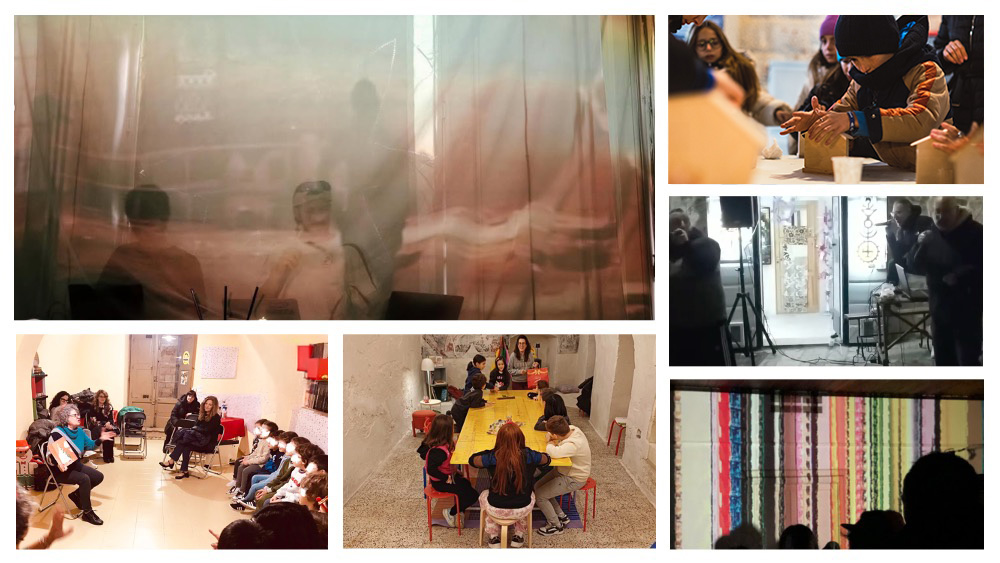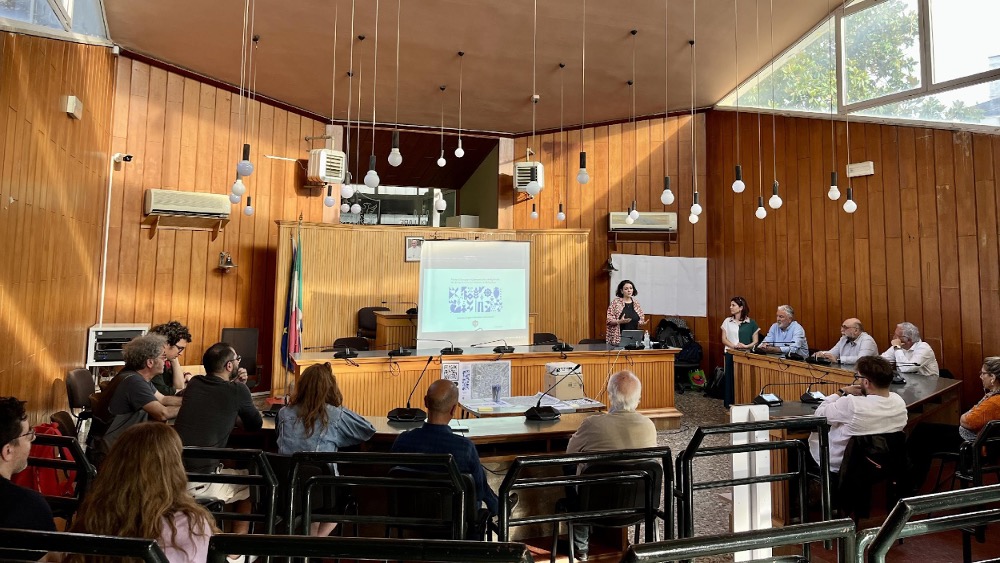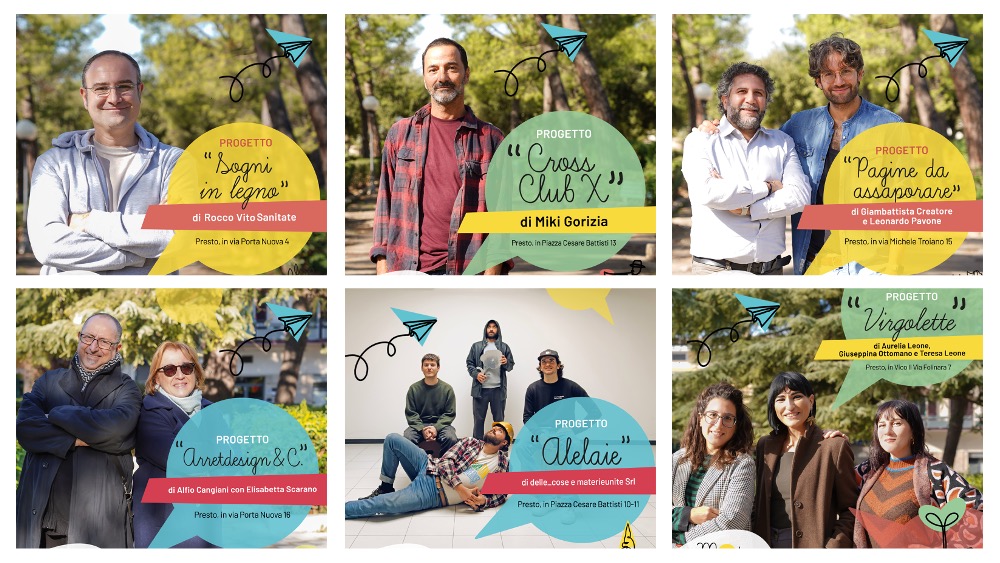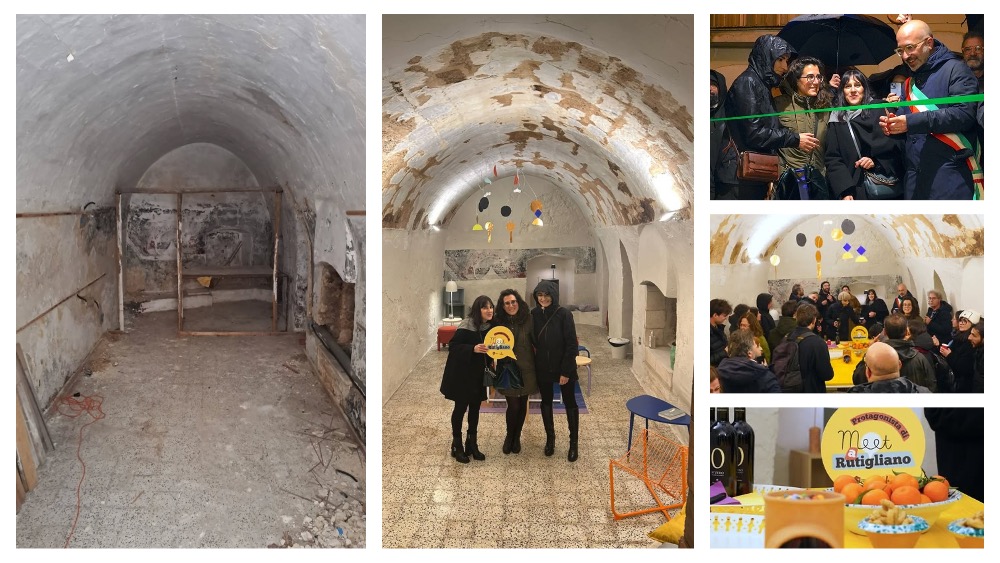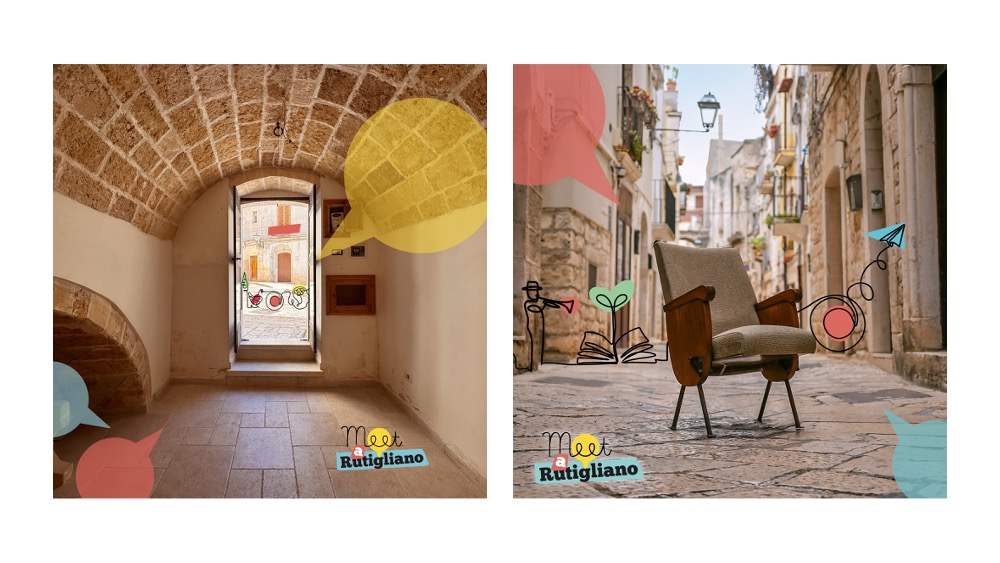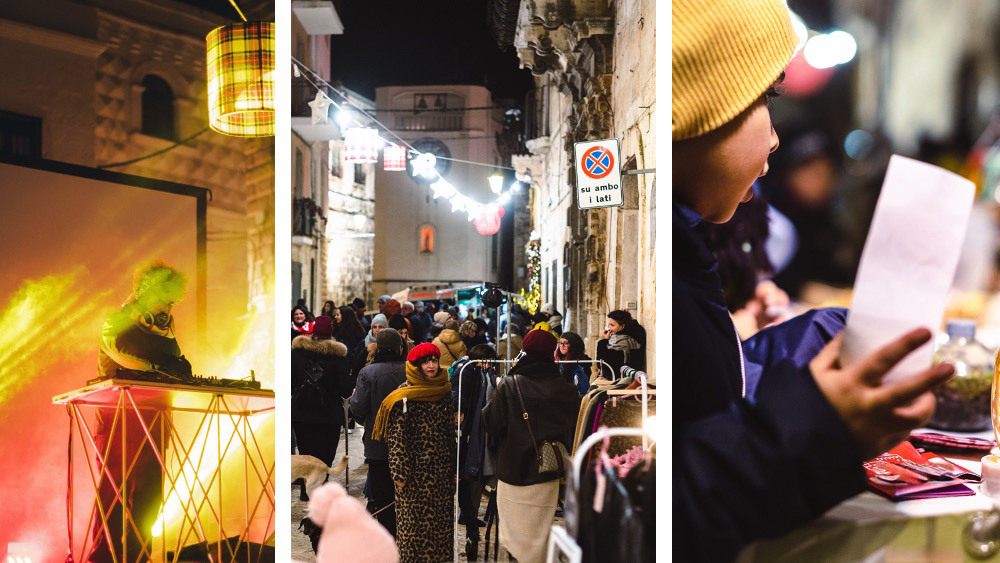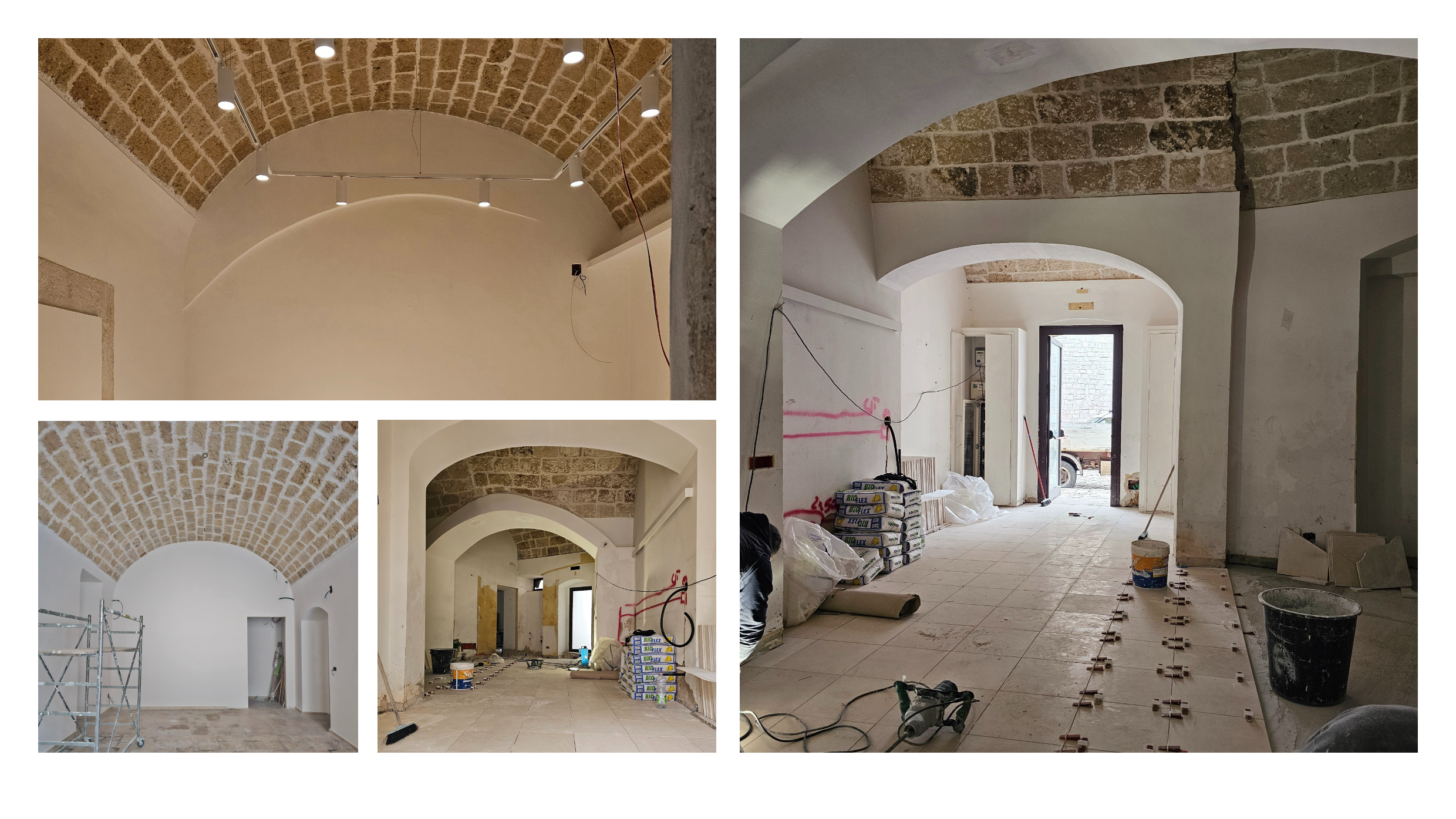Meet a Rutigliano
Meet a Rutigliano
The old town of Rutigliano is rich of historical-architectural monuments but over the last 30 years has experienced a process of abandonment.Since 2019, the reactivation of the historic center has been started, through hardware and software interventions, then included within the Commercial and Artisan Recovery Plan of the Old Town and in the Meet a Rutigliano program. The strategy includes the reactivation of abandoned spaces, through tax incentives, promotion actions and community activation.
Italy
City of Rutigliano - Historical city center
Prototype level
Yes
Yes
Yes
Yes
PNRR Piano Nazionale di Ripresa e Resilienza - Next Generation EU
No
072037: Rutigliano (IT)
The Municipality of Rutigliano is leading an extensive regeneration strategy aimed at revitalizing the old town, transforming it into an attractive and inclusive space for residents and visitors. This initiative enhances urban life quality, stimulates economic growth, and fosters social cohesion by repurposing abandoned spaces and developing new commercial, artisanal, and cultural enterprises. The strategy is built upon different projects and actions: Galloforie, Community Next, and the Recovery Plan - merged into the action program of Meet a Rutigliano, each contributing uniquely to sustainability, accessibility, and cultural activation.
Target Group(s) This strategy primarily supports:
Young adults (18-40 years old), including artisans, entrepreneurs, and cultural operators.
Local businesses and service providers, with a focus on sustainable economic models.
Residents of Rutigliano, particularly those engaged in community-driven projects.
Visitors and cultural tourists, attracted by the unique artistic and experiential aspects of the historic center.
Specific Objectives
Restore and repurpose abandoned buildings to house cultural and commercial activities.
Strengthen local economic networks through sustainable, craft-based businesses.
Promote cultural and artistic engagement through public art installations and creative initiatives.
Foster inclusive governance and co-design processes, empowering local stakeholders.
Develop green infrastructure and sustainable mobility strategies to enhance urban quality.
Expected Outcomes
Adaptive reuse of historic buildings, increasing commercial and cultural activity.
Expansion of creative businesses and local entrepreneurship.
Strengthened social inclusivity and participatory governance.
Increased footfall and engagement within the historic center.
Establishment of Rutigliano as a model for small-town urban regeneration, demonstrating the potential of place-based innovation and community-driven transformation.
Target Group(s) This strategy primarily supports:
Young adults (18-40 years old), including artisans, entrepreneurs, and cultural operators.
Local businesses and service providers, with a focus on sustainable economic models.
Residents of Rutigliano, particularly those engaged in community-driven projects.
Visitors and cultural tourists, attracted by the unique artistic and experiential aspects of the historic center.
Specific Objectives
Restore and repurpose abandoned buildings to house cultural and commercial activities.
Strengthen local economic networks through sustainable, craft-based businesses.
Promote cultural and artistic engagement through public art installations and creative initiatives.
Foster inclusive governance and co-design processes, empowering local stakeholders.
Develop green infrastructure and sustainable mobility strategies to enhance urban quality.
Expected Outcomes
Adaptive reuse of historic buildings, increasing commercial and cultural activity.
Expansion of creative businesses and local entrepreneurship.
Strengthened social inclusivity and participatory governance.
Increased footfall and engagement within the historic center.
Establishment of Rutigliano as a model for small-town urban regeneration, demonstrating the potential of place-based innovation and community-driven transformation.
Old town
Urban reuse
Cultural Development G
Social Cohesion
Economic Growth
Sustainability is central to the initiative, achieved through the adaptive reuse of abandoned buildings and urban spaces: vacant properties become new cultural and socio-economic infrastructures, where different citizens can experiment new ways of inhabiting the ancient without developing further land consumption.
By ensuring the durability, adaptability, and recyclability of existing structures, the project aligns with the NEB ambition 'to repurpose' and promotes a sustainable model of urban development.
The initiative also adheres to the ambition 'to close the loop', fostering a local circular economy by supporting businesses that promote sustainability, local craftsmanship, and short supply chains. This is exemplified by the program Meet a Rutigliano, which has activated six new commercial and cultural spaces in the old town, leading the way for a reduction of the dependence on large commercial structures.
The Community Next project also involves the construction of some sections of the network for the disposal of rainwater. The absence of a network inside the historic center of the city produces strong inconveniences due to flooding phenomena of this last decade; the project is creating the first system of underground services in the old center within the alleys most affected by these phenomena, trying, in a synergic perspective, to connect such interventions with those underway immediately adjacent to the old center.
Additionally, by revitalizing the urban core, the project encourages a shift towards pedestrian mobility, reducing reliance on automobiles and enhancing public space accessibility.
Looking forward, the initiative aspires 'to regenerate' by integrating green spaces, urban gardens, and sustainable energy solutions within the historic center. These efforts, though not yet fully realized, are guiding the direction for future interventions, reinforcing Rutigliano as a model for sustainable, human-centered urban development
By ensuring the durability, adaptability, and recyclability of existing structures, the project aligns with the NEB ambition 'to repurpose' and promotes a sustainable model of urban development.
The initiative also adheres to the ambition 'to close the loop', fostering a local circular economy by supporting businesses that promote sustainability, local craftsmanship, and short supply chains. This is exemplified by the program Meet a Rutigliano, which has activated six new commercial and cultural spaces in the old town, leading the way for a reduction of the dependence on large commercial structures.
The Community Next project also involves the construction of some sections of the network for the disposal of rainwater. The absence of a network inside the historic center of the city produces strong inconveniences due to flooding phenomena of this last decade; the project is creating the first system of underground services in the old center within the alleys most affected by these phenomena, trying, in a synergic perspective, to connect such interventions with those underway immediately adjacent to the old center.
Additionally, by revitalizing the urban core, the project encourages a shift towards pedestrian mobility, reducing reliance on automobiles and enhancing public space accessibility.
Looking forward, the initiative aspires 'to regenerate' by integrating green spaces, urban gardens, and sustainable energy solutions within the historic center. These efforts, though not yet fully realized, are guiding the direction for future interventions, reinforcing Rutigliano as a model for sustainable, human-centered urban development
The old town is defined by noble palaces and smaller abandoned spaces.
The Galloforie project enhances the town’s identity by transforming the old town into an open-air museum, where terracotta sculptures by local and international artists are installed in strategic abandoned urban locations. Rutigliano has a millennia-old tradition of terracotta craftsmanship, thanks to the unique composition of its soil. In the late 1980s, this tradition experienced a revival, particularly through the production of fischietti—small, finely crafted terracotta whistles considered true sound sculptures, shaped by the skilled hands of figuli, the master artisans. This initiative also fosters community engagement with local artistic traditions, reinforcing the connection between heritage, material culture and urban regeneration.
Community Next will create a hub for citizen participation, the city's first urban center, as well as spaces dedicated to training courses through the promotion of local traditional activities.
Meet a Rutigliano has played a pivotal role in bringing life back to abandoned spaces by financing and supporting craft-based, cultural, and commercial initiatives. The project has also contributed to the cultural and social enrichment of the city by financing a dynamic program of events promoted by the activities themselves. These include activities for children, training programs, artisanal workshops, performances and exhibitions, all of which have broadened access to cultural experiences within the old town. These initiatives, combined with the municipality’s traditional Christmas cultural programming, have significantly expanded Rutigliano’s overall cultural offering. With the Christmas installations of Rutigliano is Magic, lights and festive displays transform the historic center into an immersive urban map.
This network of regenerated spaces fosters a dynamic ecosystem where beauty serves as a guiding principle and a connective element.
The Galloforie project enhances the town’s identity by transforming the old town into an open-air museum, where terracotta sculptures by local and international artists are installed in strategic abandoned urban locations. Rutigliano has a millennia-old tradition of terracotta craftsmanship, thanks to the unique composition of its soil. In the late 1980s, this tradition experienced a revival, particularly through the production of fischietti—small, finely crafted terracotta whistles considered true sound sculptures, shaped by the skilled hands of figuli, the master artisans. This initiative also fosters community engagement with local artistic traditions, reinforcing the connection between heritage, material culture and urban regeneration.
Community Next will create a hub for citizen participation, the city's first urban center, as well as spaces dedicated to training courses through the promotion of local traditional activities.
Meet a Rutigliano has played a pivotal role in bringing life back to abandoned spaces by financing and supporting craft-based, cultural, and commercial initiatives. The project has also contributed to the cultural and social enrichment of the city by financing a dynamic program of events promoted by the activities themselves. These include activities for children, training programs, artisanal workshops, performances and exhibitions, all of which have broadened access to cultural experiences within the old town. These initiatives, combined with the municipality’s traditional Christmas cultural programming, have significantly expanded Rutigliano’s overall cultural offering. With the Christmas installations of Rutigliano is Magic, lights and festive displays transform the historic center into an immersive urban map.
This network of regenerated spaces fosters a dynamic ecosystem where beauty serves as a guiding principle and a connective element.
The initiative strongly prioritizes accessibility and economic inclusivity, ensuring that regeneration is not limited to established businesses but is open to young entrepreneurs, startups, and individuals with limited financial resources. The Meet a Rutigliano program has actively worked to allocate regenerated spaces to people aged 18 to 40, enabling those with innovative ideas but limited capital to establish a presence in the historic center.
This approach increases the accessibility of urban regeneration to a broader social demographic, ensuring that the benefits of revitalization are equitably distributed. The participants from the initial experimental phase are now part of a co-design process, shaping future interventions and reinforcing a sense of community ownership in the town’s evolution.
The project also embraces an inclusive governance model, engaging local institutions, community organizations, and private stakeholders in a participatory decision-making process.
Finally, the recovery plan provides the output of building a plural subject - able to represent the public administration but also citizens, associations, in a formula of public-private partnership - that carries out in a continuous and coordinated manner the regeneration actions foreseen by the plan. This governance formula would allow the maintenance of public interest, while gaining greater agility and responsiveness to the interests of stakeholders.
The first steps towards the constitution of this subject are taking place these days, with the start of the participatory process that follows the first experimental phase of Meet a Rutigliano.
Participation is at the heart of this initiative, moving beyond mere consultation to co-development and self-governance. The town’s residents, business owners, and cultural operators actively shape the regeneration process, ensuring that urban transformation aligns with community needs and aspirations
This approach increases the accessibility of urban regeneration to a broader social demographic, ensuring that the benefits of revitalization are equitably distributed. The participants from the initial experimental phase are now part of a co-design process, shaping future interventions and reinforcing a sense of community ownership in the town’s evolution.
The project also embraces an inclusive governance model, engaging local institutions, community organizations, and private stakeholders in a participatory decision-making process.
Finally, the recovery plan provides the output of building a plural subject - able to represent the public administration but also citizens, associations, in a formula of public-private partnership - that carries out in a continuous and coordinated manner the regeneration actions foreseen by the plan. This governance formula would allow the maintenance of public interest, while gaining greater agility and responsiveness to the interests of stakeholders.
The first steps towards the constitution of this subject are taking place these days, with the start of the participatory process that follows the first experimental phase of Meet a Rutigliano.
Participation is at the heart of this initiative, moving beyond mere consultation to co-development and self-governance. The town’s residents, business owners, and cultural operators actively shape the regeneration process, ensuring that urban transformation aligns with community needs and aspirations
The regeneration of Rutigliano’s historic center is built on active citizen participation and engagement with civil society. Through public consultations, co-design workshops, and long-term collaborative governance, the initiative ensures that residents, businesses, and cultural actors are key drivers of change.
A major achievement has been the revitalization of public spaces, particularly the Urban Center, which will now serve as a hub for cultural and social activities, promoting interaction and community-building. Simultaneously, the Meet a Rutigliano initiative has reactivated abandoned storefronts, offering affordable spaces to young entrepreneurs and artisans, making the historic center more dynamic and attractive.
This process has significantly increased safety by fostering an active urban environment with well-lit, pedestrian-friendly streets and a vibrant mix of activities. The presence of businesses and public art installations, such as those from Galloforie, has reshaped perceptions, creating a more welcoming and lively space for both residents and visitors.
Beyond physical improvements, the initiative has sought to expand the collective imagination by engaging citizens in participatory visioning exercises and open forums, encouraging them to redefine the role of the historic center as a dynamic, inclusive, and future-oriented place. By integrating public-private partnerships, financial incentives, and local policies, the initiative ensures that revitalization efforts are sustainable and continuously reinvested in the local economy.
Ultimately, this initiative demonstrates a model of participatory urban regeneration, where citizens are not only beneficiaries but co-creators of transformation. By linking spatial renewal, economic sustainability, and cultural engagement, it fosters a resilient, inclusive, and socially sustainable urban environment.
A major achievement has been the revitalization of public spaces, particularly the Urban Center, which will now serve as a hub for cultural and social activities, promoting interaction and community-building. Simultaneously, the Meet a Rutigliano initiative has reactivated abandoned storefronts, offering affordable spaces to young entrepreneurs and artisans, making the historic center more dynamic and attractive.
This process has significantly increased safety by fostering an active urban environment with well-lit, pedestrian-friendly streets and a vibrant mix of activities. The presence of businesses and public art installations, such as those from Galloforie, has reshaped perceptions, creating a more welcoming and lively space for both residents and visitors.
Beyond physical improvements, the initiative has sought to expand the collective imagination by engaging citizens in participatory visioning exercises and open forums, encouraging them to redefine the role of the historic center as a dynamic, inclusive, and future-oriented place. By integrating public-private partnerships, financial incentives, and local policies, the initiative ensures that revitalization efforts are sustainable and continuously reinvested in the local economy.
Ultimately, this initiative demonstrates a model of participatory urban regeneration, where citizens are not only beneficiaries but co-creators of transformation. By linking spatial renewal, economic sustainability, and cultural engagement, it fosters a resilient, inclusive, and socially sustainable urban environment.
The regeneration of Rutigliano’s old town has been shaped by the active involvement of stakeholders across multiple levels.
At the local level, the initiative was driven by citizens, local businesses, artisans, and cultural organizations, who engaged through public consultations, co-design workshops, and participatory planning sessions. The Meet a Rutigliano and Community Next initiatives facilitated direct community input, ensuring that the regeneration reflected local needs. The creation of the Urban Center further institutionalized community participation, providing a long-term governance structure for local engagement.
At the regional level, collaboration with public institutions and sectoral organizations helped align the initiative with broader development policies. The regional government provided technical and financial support, through the DUC - Urban Districts of Commerce program, a preferential channel of financing and regional support for the development of city commercial areas.
At the national level, the project leveraged funding and policy support from government programs aimed at urban regeneration, cultural heritage conservation, and sustainable development. The initiative benefited from frameworks such as the National Recovery and Resilience Plan (PNRR) for the Urban Center.
At the European level, the initiative aligns with the principles of the NEB, integrating sustainability, inclusion, and aesthetics into urban regeneration. The technical consultants of Meet a Rutigliano have maintained an open perspective on European dynamics, drawing inspiration from best practices in cities such as Valladolid, Ghent, Paris, Saragozza, Budapest, etc.
This multi-level engagement has ensured a cohesive, well-supported initiative, bridging local aspirations with national and European strategies, making Rutigliano a replicable model for small municipalities across Europe
At the local level, the initiative was driven by citizens, local businesses, artisans, and cultural organizations, who engaged through public consultations, co-design workshops, and participatory planning sessions. The Meet a Rutigliano and Community Next initiatives facilitated direct community input, ensuring that the regeneration reflected local needs. The creation of the Urban Center further institutionalized community participation, providing a long-term governance structure for local engagement.
At the regional level, collaboration with public institutions and sectoral organizations helped align the initiative with broader development policies. The regional government provided technical and financial support, through the DUC - Urban Districts of Commerce program, a preferential channel of financing and regional support for the development of city commercial areas.
At the national level, the project leveraged funding and policy support from government programs aimed at urban regeneration, cultural heritage conservation, and sustainable development. The initiative benefited from frameworks such as the National Recovery and Resilience Plan (PNRR) for the Urban Center.
At the European level, the initiative aligns with the principles of the NEB, integrating sustainability, inclusion, and aesthetics into urban regeneration. The technical consultants of Meet a Rutigliano have maintained an open perspective on European dynamics, drawing inspiration from best practices in cities such as Valladolid, Ghent, Paris, Saragozza, Budapest, etc.
This multi-level engagement has ensured a cohesive, well-supported initiative, bridging local aspirations with national and European strategies, making Rutigliano a replicable model for small municipalities across Europe
Meet a Rutigliano integrates expertise from multiple disciplines and knowledge fields, ensuring a holistic and sustainable transformation. The collaboration between diverse professional sectors has enriched the initiative, allowing for innovative solutions and cross-sectoral synergies.
The project incorporates urban planning and programming, guiding the spatial organization of interventions, ensuring coherence with broader urban policies, and aligning with sustainable development principles. Architectural design has played a fundamental role in repurposing abandoned spaces, restoring historic buildings, and adapting them for contemporary cultural, commercial, and social uses.
Craftsmanship and artisanal practices have been central to the initiative, particularly through the Meet a Rutigliano and Galloforie projects, which have revitalized local traditions and fostered new business opportunities. The integration of arts and performance has further activated public spaces, making them more dynamic through installations, exhibitions, and live performances.
Communication and cultural event organization have facilitated community engagement, ensuring that residents and visitors are informed and actively involved. A strong emphasis on social activities has helped create an inclusive environment, where different generations and backgrounds contribute to shaping the new identity of the old town.
Additionally, the initiative has required legal expertise to navigate regulations related to the temporary reuse of abandoned spaces. By developing adaptable legal frameworks that facilitate the short-term activation of vacant buildings, the initiative ensures that unused spaces can be repurposed for cultural, social, and entrepreneurial activities.
These disciplines have worked together through co-design workshops, interdisciplinary meetings, and participatory planning sessions, ensuring that each sector’s knowledge contributes to a cohesive vision
The project incorporates urban planning and programming, guiding the spatial organization of interventions, ensuring coherence with broader urban policies, and aligning with sustainable development principles. Architectural design has played a fundamental role in repurposing abandoned spaces, restoring historic buildings, and adapting them for contemporary cultural, commercial, and social uses.
Craftsmanship and artisanal practices have been central to the initiative, particularly through the Meet a Rutigliano and Galloforie projects, which have revitalized local traditions and fostered new business opportunities. The integration of arts and performance has further activated public spaces, making them more dynamic through installations, exhibitions, and live performances.
Communication and cultural event organization have facilitated community engagement, ensuring that residents and visitors are informed and actively involved. A strong emphasis on social activities has helped create an inclusive environment, where different generations and backgrounds contribute to shaping the new identity of the old town.
Additionally, the initiative has required legal expertise to navigate regulations related to the temporary reuse of abandoned spaces. By developing adaptable legal frameworks that facilitate the short-term activation of vacant buildings, the initiative ensures that unused spaces can be repurposed for cultural, social, and entrepreneurial activities.
These disciplines have worked together through co-design workshops, interdisciplinary meetings, and participatory planning sessions, ensuring that each sector’s knowledge contributes to a cohesive vision
While traditional regeneration projects often focus mainly on infrastructure improvement or commercial revitalization, this initiative takes a holistic, interdisciplinary, and community-driven approach.
A key innovation lies in the integration of culture, craftsmanship, and participatory governance as primary tools for transformation. Instead of relying only on top-down urban planning, the initiative leverages Meet a Rutigliano, a program that assigns repurposed spaces to young entrepreneurs, artists, and artisans through accessible economic models such as free loan agreements (comodato d’uso gratuito). This not only lowers economic barriers but also ensures that regeneration is led by emerging creative and cultural actors, fostering a new economic ecosystem.
The Community Next vision has activated residents through co-design workshops and cultural mapping, ensuring that urban regeneration is not just about physical renovation but also about re-establishing a sense of place and collective ownership.
Moreover, the initiative innovates by blending artistic and performative elements into urban transformation. Through the Galloforie, abandoned and degraded urban areas have been turned into public art galleries: the decision to guide visitors through the most degraded and abandoned areas is a strategic choice that activates a flow of people, eyes, and attention in these places, increasing social surveillance and preventing potential urban decay and unsafe conditions through passive community oversight.
Unlike standard revitalization efforts that prioritize economic returns, this initiative is distinguished by its constant interaction with the community and its cultural identity. This continuous engagement ensures that urban regeneration is deeply tied to the genius loci, becoming an authentic expression of the people who live, work, and dream in the city every day.
A key innovation lies in the integration of culture, craftsmanship, and participatory governance as primary tools for transformation. Instead of relying only on top-down urban planning, the initiative leverages Meet a Rutigliano, a program that assigns repurposed spaces to young entrepreneurs, artists, and artisans through accessible economic models such as free loan agreements (comodato d’uso gratuito). This not only lowers economic barriers but also ensures that regeneration is led by emerging creative and cultural actors, fostering a new economic ecosystem.
The Community Next vision has activated residents through co-design workshops and cultural mapping, ensuring that urban regeneration is not just about physical renovation but also about re-establishing a sense of place and collective ownership.
Moreover, the initiative innovates by blending artistic and performative elements into urban transformation. Through the Galloforie, abandoned and degraded urban areas have been turned into public art galleries: the decision to guide visitors through the most degraded and abandoned areas is a strategic choice that activates a flow of people, eyes, and attention in these places, increasing social surveillance and preventing potential urban decay and unsafe conditions through passive community oversight.
Unlike standard revitalization efforts that prioritize economic returns, this initiative is distinguished by its constant interaction with the community and its cultural identity. This continuous engagement ensures that urban regeneration is deeply tied to the genius loci, becoming an authentic expression of the people who live, work, and dream in the city every day.
The regeneration of Rutigliano’s historic center follows a progressive, participatory methodology, where bottom-up initiatives have driven structured regeneration efforts.
The process began with Galloforie,also aimed to bring the defining element of this region—terracotta—out of museums and palaces, making it accessible to the entire community as a living part of their heritage. By placing these cultural symbols in neglected urban areas, the project not only raises awareness but also activates abandoned spaces.
The Community Next program marked the first structured intervention by securing funding to restore the only public space in the historic center, establishing a focal point for cultural and community activities. After completing the planning and financing of this public space, the initiative expanded its focus to the private sector, targeting abandoned and underutilized properties. Recognizing the potential, the municipality committed to developing a broader strategy that would integrate these efforts, ensuring that both public and private assets contributed to the regeneration process.
The first step was a survey and mapping of abandoned spaces, classifying them by size, condition, and potential use. The second phase focused on stakeholder mapping, identifying groups interested in occupying and revitalizing these spaces.
The strategy established five key action areas:
Policies and Incentives
Community Actions
Historic and Architectural Heritage
Cultural and Artistic Assets
Infrastructure and Accessibility
The plan culminated in Meet a Rutigliano, which enabled the temporary reuse of vacant spaces for artisanal, cultural, and entrepreneurial activities, facilitating the activation of a demand-supply market between private property owners and emerging businesses. The municipality acts as a guarantor and provides financial support for this experimental phase, ensuring that the process is sustainable and can be scaled over time
The process began with Galloforie,also aimed to bring the defining element of this region—terracotta—out of museums and palaces, making it accessible to the entire community as a living part of their heritage. By placing these cultural symbols in neglected urban areas, the project not only raises awareness but also activates abandoned spaces.
The Community Next program marked the first structured intervention by securing funding to restore the only public space in the historic center, establishing a focal point for cultural and community activities. After completing the planning and financing of this public space, the initiative expanded its focus to the private sector, targeting abandoned and underutilized properties. Recognizing the potential, the municipality committed to developing a broader strategy that would integrate these efforts, ensuring that both public and private assets contributed to the regeneration process.
The first step was a survey and mapping of abandoned spaces, classifying them by size, condition, and potential use. The second phase focused on stakeholder mapping, identifying groups interested in occupying and revitalizing these spaces.
The strategy established five key action areas:
Policies and Incentives
Community Actions
Historic and Architectural Heritage
Cultural and Artistic Assets
Infrastructure and Accessibility
The plan culminated in Meet a Rutigliano, which enabled the temporary reuse of vacant spaces for artisanal, cultural, and entrepreneurial activities, facilitating the activation of a demand-supply market between private property owners and emerging businesses. The municipality acts as a guarantor and provides financial support for this experimental phase, ensuring that the process is sustainable and can be scaled over time
A key transferable element of this initiative is the ability to transform urban weaknesses into opportunities. The project demonstrates how underutilized and abandoned spaces—often seen as problems—can become catalysts for urban regeneration.
A replicable practice is the mapping of abandoned spaces, not only public but also private, and working in synergy with property owners and local stakeholders to reactivate them. This process enables municipalities to quantify unused assets, understand their potential, and create mechanisms to support their transformation.
Another transferable aspect is the use of small but effective municipal incentives to stimulate citizen-led initiatives. Instead of relying on large-scale investments, the initiative proves that small, well-structured financial measures can unlock participation. Another piece of the strategy was 'Un Seme di Pace' initiative, an open call for proposals aimed at engaging all the citizens in the creation of holiday decorations and installations within the historic center. This initiative demonstrates how small-scale financial support can activate local engagement, enhance urban aesthetics, and foster a sense of collective belonging.
The integration of temporary use models allows for dynamic and adaptable urban experimentation. At the same time, elements like the Urban Center provide a more stable reference point for long-term governance and engagement. This hybrid approach—combining flexible interventions with more structured infrastructures—offers a scalable model for cities looking to balance short-term activation with long-term resilience.
More than a set of technical solutions, this initiative serves as a gentle push to expand collective urban imagination. The ability to make change tangible, to encourage communities to see new possibilities in their built environment, and to create a sense of agency in city-making are fundamental elements that can be adapted and implemented in diverse urban contexts
A replicable practice is the mapping of abandoned spaces, not only public but also private, and working in synergy with property owners and local stakeholders to reactivate them. This process enables municipalities to quantify unused assets, understand their potential, and create mechanisms to support their transformation.
Another transferable aspect is the use of small but effective municipal incentives to stimulate citizen-led initiatives. Instead of relying on large-scale investments, the initiative proves that small, well-structured financial measures can unlock participation. Another piece of the strategy was 'Un Seme di Pace' initiative, an open call for proposals aimed at engaging all the citizens in the creation of holiday decorations and installations within the historic center. This initiative demonstrates how small-scale financial support can activate local engagement, enhance urban aesthetics, and foster a sense of collective belonging.
The integration of temporary use models allows for dynamic and adaptable urban experimentation. At the same time, elements like the Urban Center provide a more stable reference point for long-term governance and engagement. This hybrid approach—combining flexible interventions with more structured infrastructures—offers a scalable model for cities looking to balance short-term activation with long-term resilience.
More than a set of technical solutions, this initiative serves as a gentle push to expand collective urban imagination. The ability to make change tangible, to encourage communities to see new possibilities in their built environment, and to create a sense of agency in city-making are fundamental elements that can be adapted and implemented in diverse urban contexts
A major challenge faced by cities worldwide is the unsustainable expansion of urban areas, leading to land consumption and increased carbon footprints. This initiative counteracts urban sprawl by repurposing existing spaces instead of constructing new ones. Through the Meet a Rutigliano program and the rehabilitation of abandoned buildings, the initiative reduces construction waste, promotes energy efficiency, and fosters circular economy practices, aligning with global climate action goals.
Many small towns struggle with economic stagnation and youth migration due to a lack of opportunities. This initiative provides accessible spaces for entrepreneurship and cultural activities, particularly through the comodato d’uso gratuito model, which eliminates financial barriers for young professionals, artisans, and creatives. By fostering local job creation and economic diversification, the project provides an equitable development model that can be replicated in other underserved communities.
The abandonment of historic centers is a growing global issue, leading to loss of heritage and weakening of local identities. The initiative reverses this trend by using cultural and artistic interventions, such as the Galloforie open-air museum, to revitalize public spaces and reconnect communities with their heritage. By placing culture at the core of urban regeneration, the initiative demonstrates how historic preservation can be a driver of sustainable urban renewal.
Rapid urbanization often leads to social fragmentation, with residents disconnected from decision-making processes. The Urban center ensures that local voices are actively involved in shaping the future of their town through co-design workshops and participatory governance.
Many cities face the challenge of implementing inclusive and participatory urban policies. Through public-private partnerships and adaptive legal frameworks, Rutigliano’s experience can inform urban regeneration strategies worldwide.
Many small towns struggle with economic stagnation and youth migration due to a lack of opportunities. This initiative provides accessible spaces for entrepreneurship and cultural activities, particularly through the comodato d’uso gratuito model, which eliminates financial barriers for young professionals, artisans, and creatives. By fostering local job creation and economic diversification, the project provides an equitable development model that can be replicated in other underserved communities.
The abandonment of historic centers is a growing global issue, leading to loss of heritage and weakening of local identities. The initiative reverses this trend by using cultural and artistic interventions, such as the Galloforie open-air museum, to revitalize public spaces and reconnect communities with their heritage. By placing culture at the core of urban regeneration, the initiative demonstrates how historic preservation can be a driver of sustainable urban renewal.
Rapid urbanization often leads to social fragmentation, with residents disconnected from decision-making processes. The Urban center ensures that local voices are actively involved in shaping the future of their town through co-design workshops and participatory governance.
Many cities face the challenge of implementing inclusive and participatory urban policies. Through public-private partnerships and adaptive legal frameworks, Rutigliano’s experience can inform urban regeneration strategies worldwide.
The evolution of Meet a Rutigliano is structured around a continuous and adaptive process, integrating feedback from stakeholders and aligning with the NEB principles. The next phases focus on strengthening governance, expanding the initiative, and refining financial and strategic support.
Planned Activities for Further Development
Co-Design and Participatory Process
February 2024: Series of workshops with local administration, property owners, and business operators to refine expectations and define financial and operational strategies
Stakeholder engagement surveys: Understanding the needs of new and historic businesses beyond financial aid, including support in marketing, digital commerce, and cultural crowdfunding initiatives.
Expansion and Reopening of Calls
Rolling re-opening of the property call, making new spaces available
Structuring Meet a Rutigliano as an Ongoing Process
Longer-term activity calls (up to one year) based on insights from previous phases
Refinement of financial support across three pillars:
Space Rehabilitation
Civic Engagement
Entrepreneurial Support
Implementation of NEB Values and Principles
Sustainability: The initiative prioritizes adaptive reuse over new construction
Inclusion: The process actively involves youngsters, local businesses, artisans, and cultural actors in shaping urban development
Aesthetics: The integration of public art, creative entrepreneurship, and cultural installations elevates the historic center’s visual and experiential appeal.
Next Steps for Implementation
2025: Refinement of the property activation strategy, further engagement with the stakeholders
2025: Finalization of the Urban Center, creating a permanent space for civic and cultural coordination
Beyond 2025: Establishment of a long-term governance structure, ensuring financial viability and continuous urban regeneration
Planned Activities for Further Development
Co-Design and Participatory Process
February 2024: Series of workshops with local administration, property owners, and business operators to refine expectations and define financial and operational strategies
Stakeholder engagement surveys: Understanding the needs of new and historic businesses beyond financial aid, including support in marketing, digital commerce, and cultural crowdfunding initiatives.
Expansion and Reopening of Calls
Rolling re-opening of the property call, making new spaces available
Structuring Meet a Rutigliano as an Ongoing Process
Longer-term activity calls (up to one year) based on insights from previous phases
Refinement of financial support across three pillars:
Space Rehabilitation
Civic Engagement
Entrepreneurial Support
Implementation of NEB Values and Principles
Sustainability: The initiative prioritizes adaptive reuse over new construction
Inclusion: The process actively involves youngsters, local businesses, artisans, and cultural actors in shaping urban development
Aesthetics: The integration of public art, creative entrepreneurship, and cultural installations elevates the historic center’s visual and experiential appeal.
Next Steps for Implementation
2025: Refinement of the property activation strategy, further engagement with the stakeholders
2025: Finalization of the Urban Center, creating a permanent space for civic and cultural coordination
Beyond 2025: Establishment of a long-term governance structure, ensuring financial viability and continuous urban regeneration

